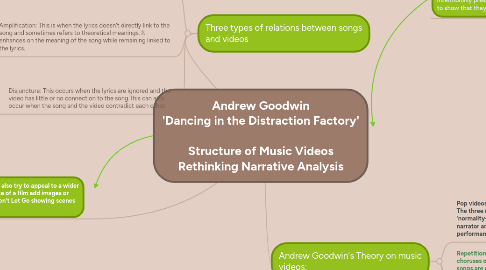
1. Three types of relations between songs and videos
1.1. Illustration: This is when the video demonstrates the song lyric through either a performance, visual images or words.
1.1.1. Beyonce - Pretty Hurts This is an example because the meaning of the song is performed by Beyonce, in a pageant scenario. The lyrics are about how the world's socially constructed view of how females should be, effecting girls' happiness on the inside, while they try and 'fix' the way they look on the outside. As the song goes on and we see more and more how 'pretty hurts', Beyonce's actions becomes more aggressive and painful, which illiterates the song well.
1.2. Amplification: This is when the lyrics doesn't directly link to the song and sometimes refers to theoretical meanings. It enhances on the meaning of the song while remaining linked to the lyrics.
1.2.1. Ed Sheeran - Give Me Love This is an example of Amplification because the video shows a girl performing the role of cupid and she is 'giving out love'. But the idea that she is not a typical 'cupid' through suggestion that she is not a very happy/graceful cupid, not receiving love herself or through the scene of her death at the end, add new meanings to the video and song.
1.3. Disjuncture: This occurs when the lyrics are ignored and the video has little or no connection to the song.This can also occur when the song and the video contradict each other.
1.3.1. Dr. Dre - Still D.R.E ft Snoop Dogg This song is simply about Dr. Dre is still the same man, famous, as he was before. The video doesn't correlate with the lyrics in anyway, and it mostly focuses of the objectification of women and their bodies, and the expensive cars.
